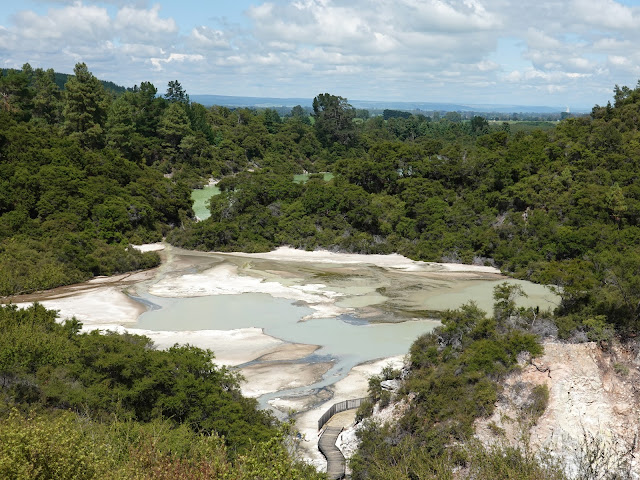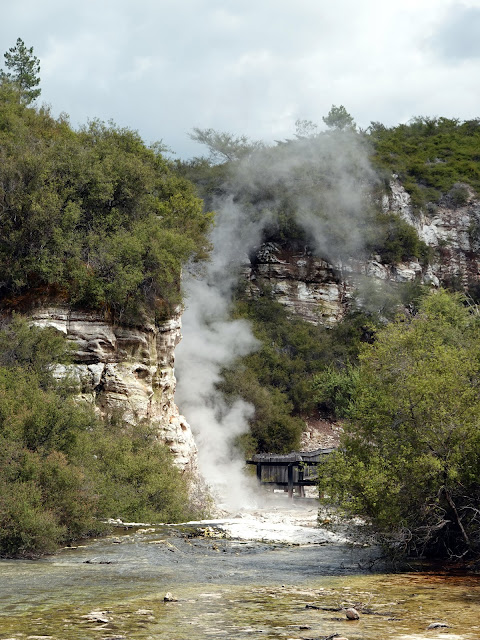Wai-o-tapu 04-03-2023
This map was created using GPS Visualizer's do-it-yourself geographic utilities.
Please wait while the map data loads...
Route: Waiotapu Loop Road, Weather Pool, Devil's Home, Rainbow Crater, Devil's Ink Pots, Artist's Palette, Champagne Pool, Primrose Terrace, Panoramic View, Bridal Veil Falls, Lake Ngakoro, Osyer Pool, Frying Pan Flat, Alum Cliffs, Sinter Terrace, Champagne Pool, Devil's Bath
Date: 02/03/2023
From: Waiotapu Loop Road
Parking: Wai-o-Tapu Car Park
Start Point: Geyser Cafe
Finish Point: Geyser Cafe
Region: Rotorua
Route length: 1.5km
Time taken: 00:40
Average speed: 4.9km/h
Ascent: 67m
Descent: 71m
Points of Interest: Artist's Palette, Champagne Pool, Lake Ngakoro, Roto Kārikitea
Wai-o-tapu is a must-visit if you find yourself in or around Rotorua on New Zealand's North Island (Te Ika-a-Māui). The small reserve is home to some dramatic geothermal features that truly defy belief. While it is a paid tourist attraction, the area can only be accessed on foot and makes for an interesting couple of hours.
The entire area is an extremely active geothermal area at the southern end of the Okataina Volcanic Centre, in New Zealand's Taupō Volcanic Zone. Hot springs and geysers are dotted across the North Island but none are as impressive as those found in Wai-o-tapu.
The name Wai-o-tapu (or waiotapu) is Māori for sacred waters and has been a protected reserve since the 1930s. The site is currently owned by a local Māori tribal business and has been since 2012. As a result, all the features have dropped their European names in favour of the local Māori name. I've tried to represent both here.
There are three marked, intertwined trails and if you complete all three (visiting every feature) it should take you around 90 minutes - perfect if you are short on time. From the visitor centre, the first loop begins in a clockwise direction crossing Waiotapu Stream on a bridge, where you'll see your first steaming hot spring.
 |
| Entrance to the reserve |
 |
| Waiotapu Stream |
 |
| Waiotapu Stream |
The spring is followed by four craters (Māhanga Rua, Te Rua Uenuku, Te Rui Whaitiri and Ipu). In total, there are around twenty craters at Wai-o-tapu that are typically up to 20 metres deep. They are formed by acidic steam rising up from beneath the earth’s surface that erodes the rock causing it to collapse.
 |
| The first of the craters - Māhanga Rua (also the Devil's Home) |
 |
| Inside Te Rua Uenuku - the Rainbow Crater |
The craters are tinged a variety of colours by the minerals in the steam that oxidise as they come into contact with the earth’s atmosphere creating hues of brown, purple, red, orange and yellow. At the base some are dry, others contain boiling mud, water and even oil.
 |
| The Artist's Palette |
 |
| The edge of the Champagne Pool |
 |
| Foreground Pool within the Artist's Palette |
There is a wooden boardwalk that links the Artist's Palette to the Champagne Pool, passing the top of the Sinter Terraces on the way (these are better seen later. At the end of the boardwalk is the Champagne Pool which gets its name from the carbon dioxide bubbles that form in the waters, not unlike a champagne glass. It is the largest spring in the geothermal Rotorua region, measuring 65m in diameter and 60m deep. Thanks to its sensational colours, it is the most photographed spot at Wai-o-tapu.
 |
| Crossing the boardwalk |
 |
| The Champagne Pool |
It was formed some 700 years ago during a hydrothermal eruption, leaving a crater full of water at 74°C. The dramatic colour in the outer ring comes from orpiment, an arsenic and sulphite mineral with a deep orange-yellow colour.
 |
| The Champagne Pool |
Champagne Pool sits at the top of the first loop so you could head back to the car park from here if you were short of time. Otherwise, continue on and start the second loop. There is a brief climb that takes you along a ridge that passes a couple of viewpoints overlooking the Sinter Terrace and thermal lake Papa Wera.
 |
| The Artist's Palette boardwalk |
 |
| The Artist's Palette |
 |
| Rua Pūmahu - the Inferno Cave |
From Rua Pūmahu the path passes Rua Ōwhanga (Birds Nest Cave). The large crater has been put to good use by nature. Swallows, starlings and mynahs have built their nests on the crater wall and the heat that rises up helps to incubate the eggs. The large mountain you can see in the background of the image below is the volcano Maungakakaramea, also known as Rainbow Mountain.
 |
| Rua Ōwhanga |
 |
| Small nests dot the walls of Rua Ōwhanga |
The final highlight is the spectacular Roto Kārikitea (the Devil's Bath or Green Light Lake). The bright green pond really has to be seen to be believed and, despite its appearance, it's entirely natural. The bright green water gets its colour from deposits of sulphur that rise to the surface and float on top.
 |
| Roto Kārikitea - the Devil's Bath |
 |
| Roto Kārikitea - notice the change in colour as soon as the sun went behind a cloud |
While there are many sites listed on the map, each loop is well worth doing. Despite the Champagne Pool, Artist's Palette and Roto Kārikitea being located close together, a trip to the far end to see Lake Ngakoro and its waterfall are highlights not to miss. If you have the time and are able to walk the distance, it is all well worth seeing.

































.jpg)













No comments :
Post a Comment